Southern charm isn’t the only thing you’re going to enjoy in Mississippi! The relatively small state is a wildlife haven for all kinds of birds.
The state is home to more than 426 species of birds, according to the Mississippi Ornithological Society Bird Records Committee (MBRC).
If you want to know more about the wide variety of birds in Mississippi, you’re in for a treat! In today’s article, we’ll walk you through a quick and descriptive guide of the most impressive and colorful birds that you can stumble across when you’re in the state of Mississippi. Let’s jump right in!
Red Birds in Mississippi
House Finch

- Scientific Name: Haemorhous mexicanus
- Length: 4.9 to 6.1 in
- Weight: 0.6 to 0.9 oz
- Wingspan: 8.1 to 10.5 in
Let’s start with one of the most common birds in Mississippi. Although it’s easy to spot and identify the bird in your backyard, it’s still one of the most impressive and mesmerizing birds to watch. This is because Finches have a habit of landing in backyards and even nesting in bird boxes like common house wrens.
The main difference between the two birds is that the males of this species have a remarkable rosy and reddish-pink plumage that covers their upper body, including breasts and faces. Females, on the other hand, have a pale brown body color like most birds.
Though the males’ color is mainly due to pigments, their diet heavily affects the intensity, so brightness can vary significantly. The males also have a beautiful song that they use to attract females for breeding.
Northern Cardinal
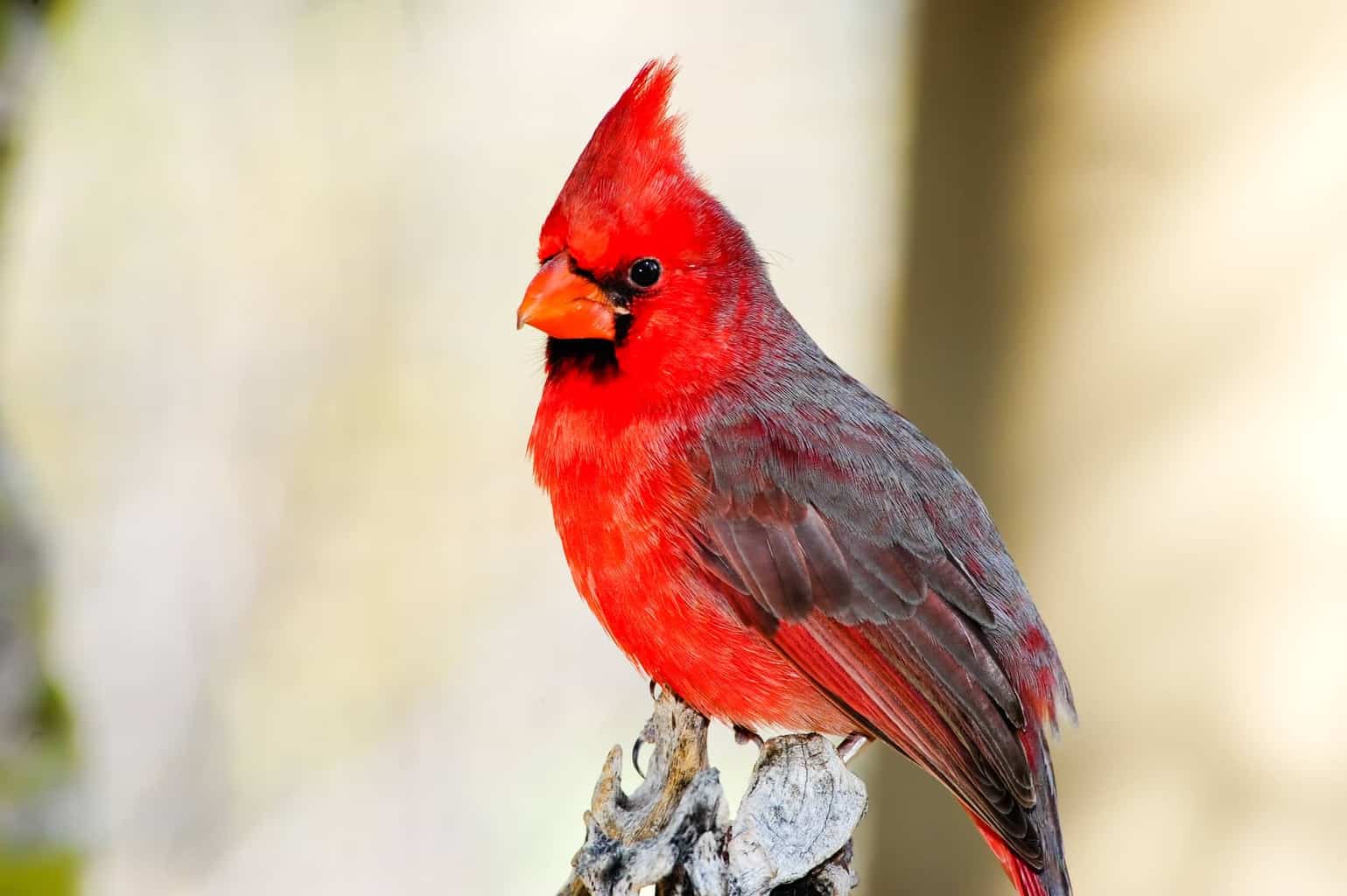
- Scientific Name: Cardinalis cardinalis
- Length: 8.3 to 9.1 In
- Weight: 1.5 to 1.7 oz
- Wingspan: 8.9 to 12.2 In
The Northern Cardinal is a common bird that is highly pleasing to watch because of the brilliant red plumage that covers the majority of the male body, sparse black and white spots on the wings, and the unique crest on the head of both birds.
Females typically have duller colors than males, with a primarily pale brown color covering their faces, backs, and breasts. However, the bird might still have a few patches of red, especially on the crest, wings, and tail.
The Northern Cardinals’ relatively large bill allows them to eat a variety of seeds. When they’re not hovering around your backyard, you can find these aggressive birds all year round in open wooded areas.
Downy Woodpecker

- Scientific Name: Dryobates pubescens
- Length: 5.5 to 7.1 In
- Weight: 0.7 to 1.1 oz
- Wingspan: 9.8 to 12.2 In
The Downy Woodpecker is one of the smallest species of woodpeckers found in the state, as well as North America.
They have black feathers covering their body and a very characteristic red patch on the back of their head, a white stripe down the front of their head, as well as a black tail with white edges.
Though they typically peck at the bark of trees looking for insects, the downy woodpecker is well-adapted to residential areas and can land in your yard while foraging or even nest in a nearby bird box.
In addition to fruits and seeds, the bird is known for enjoying various food remains, such as donuts!
Hairy Woodpecker
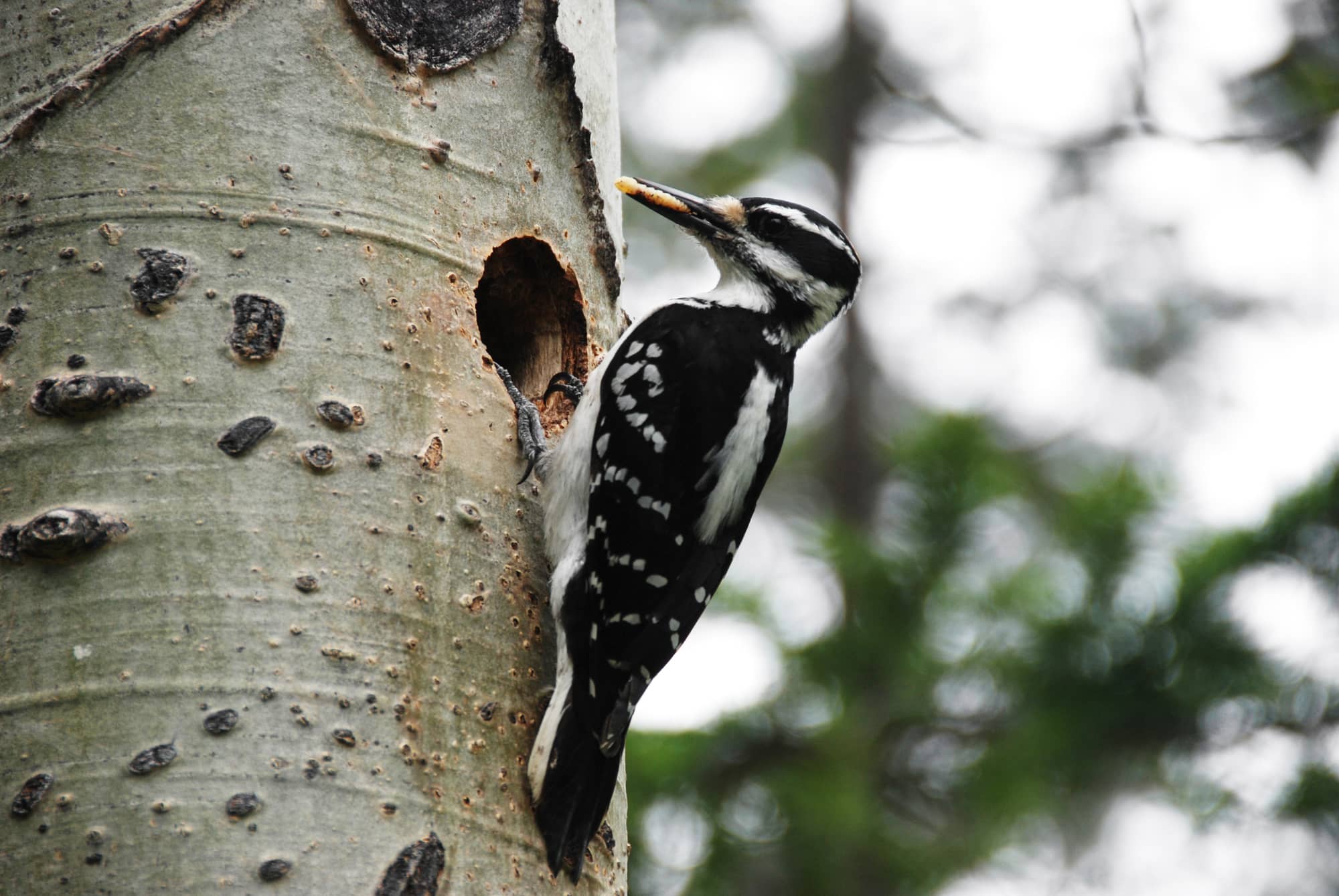
- Scientific Name: Dryobates villosus
- Length: 7.1 to 10.2 in
- Weight: 1.4 to 3.4 oz
- Wingspan: 13.0 to 17.0 in
The Hairy Woodpecker is the larger version of the Downy Woodpecker. Like the little bird, this one is also quite common in Mississippi and neighboring states. You’ll find these common visitors everywhere from mature forests and deep woods to backyard feeders.
This bird has a remarkably stockier body and a larger bill-to-body ratio than the Downy Woodpecker. It has white outer tail feathers and a similar red patch on the head to help you identify it. They also have a strong beak that they use to dig into trees for insects.
In addition to all these similarities, they’re also attracted to the same type of food. In other words, a bird feeder with food remains, seeds, and fruits will attract both birds, which is why size is your best tool to tell them apart.
Red-Winged Blackbird

- Scientific name: Agelaius phoeniceus
- Length: 6.7 to 9.1 in
- Weight: 1.1 to 2.7 oz
- Wingspan: 12.2 to 15.8 in
Despite their name, Blackbirds exist in a variety of species and colors. However, this bird is one of the few that genuinely lives up to its name!
The male red-winged blackbird is almost wholly covered with a black coat of feathers with a noticeable soft luster. However, it has a patch of vibrant red feathers that cover its shoulders along with a bottom layer of yellow.
Females have a different dark brown coloration pattern with heavy streaking across the body, and they’re often spotted together with the males, so they’re easy to identify. You’ll typically find this bird around water fountains and other water bodies, such as lakes, marshes, and streams.
Red-Bellied Woodpecker

- Scientific Name: Melanerpes carolinus
- Length: 9.2 to 10.3 In
- Weight: 2.2 to 3.2 oz
- Wingspan: 15.7 to 17.8 In
The fantastic collection of common Woodpeckers in Mississippi doesn’t end at the Downy and Hairy Woodpeckers, but it also features the amazing Red-bellied Woodpecker.
The females and males of this species look similar. You can identify the bird by its unmistakable barred back and orange-red patch on its head. As the name suggests, the bird also has a reddish tint on its belly. However, the coloration is extremely faint and overshadowed by other identifying features.
This bird feeds on insects and small fishes, so you can usually spot them around places where they can catch these creatures. Yet, they’re also adapted to residential areas and may nest in holes made in a nearby tree trunk with their pointy beak.
Blue Birds in Mississippi
Blue Jay

- Scientific Name: Cyanocitta cristata
- Length: 8.6 to 11.8 in
- Weight: 2.5 to 3.5 oz
- Wingspan: 13.3 to 16.9 in
Blue Jays are among the most common blue-colored birds in the state of Mississippi. The bird has beautiful plumage colors ranging from a unique cyan to sky blue color.
However, this coloration is due to light reflection through their unique feather structure and not pigments. Despite this fantastic coloration, many people don’t like Blue Jays because their vocalization is extremely loud and noisy for their size. The bird can sing continuously for up to 2 minutes.
Blue Jays are intelligent birds that usually imitate the sound of hawks and ospreys to warn other birds. Also, they’re capable of cracking a nut open, which is quite a rare skill among birds.
Common Grackle
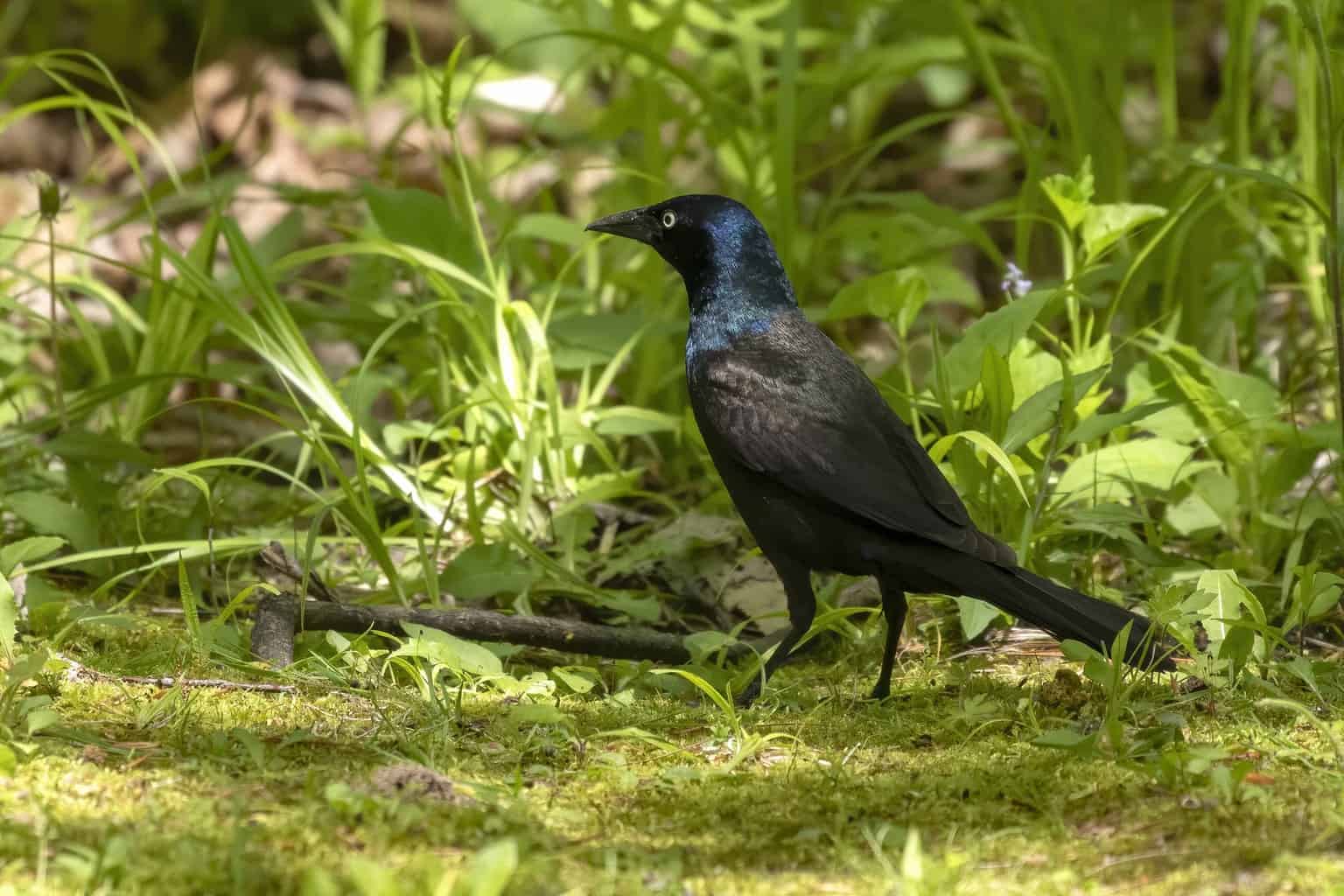
- Scientific name: Quiscalus quiscula
- Length: 11.0 to 13.4 in
- Weight: 2.6 to 5.0 oz
- Wingspan: 14.2 to 18.1 in
The Common Grackle is among the birds that you can find in Mississippi all year round. The birds are abundant in the state and are noted for their astonishing brilliant blue head. Not only that, but the feathers will also reflect light and change the shade of blue as you approach them from various angles.
Common Grackle males have a unique plumage of blue, brown, and purple. The birds typically live in flocks and make loud calls together, which makes them easy to spot.
Eastern Bluebird

- Scientific Name: Sialia sialis
- Length: 6.3 to 8.3 in
- Weight: 0.9 to 1.2 oz
- Wingspan: 9.8 to 12.6 in
The Eastern Bluebird is one of the most beautiful birds in Mississippi and is known for its lovely and soft vocalization while signing.
The bird likes to perch on utility and telephone wires. You can find them almost anywhere. They call cemeteries, golf courses, and parks home as easily as marshes and woods. However, they can still land on your bird feeder if you fill them up with their favorite foods, such as mealworms, berries, and all kinds of insects.
They’re among the few common feeder birds that share the same color patterns between sexes. However, males are typically more vibrant than females.
As you might expect, the Eastern Bluebird has blue wings, back, and head. However, the rest of their body is white with an orange-brown plumage.
Blue Grosbeak
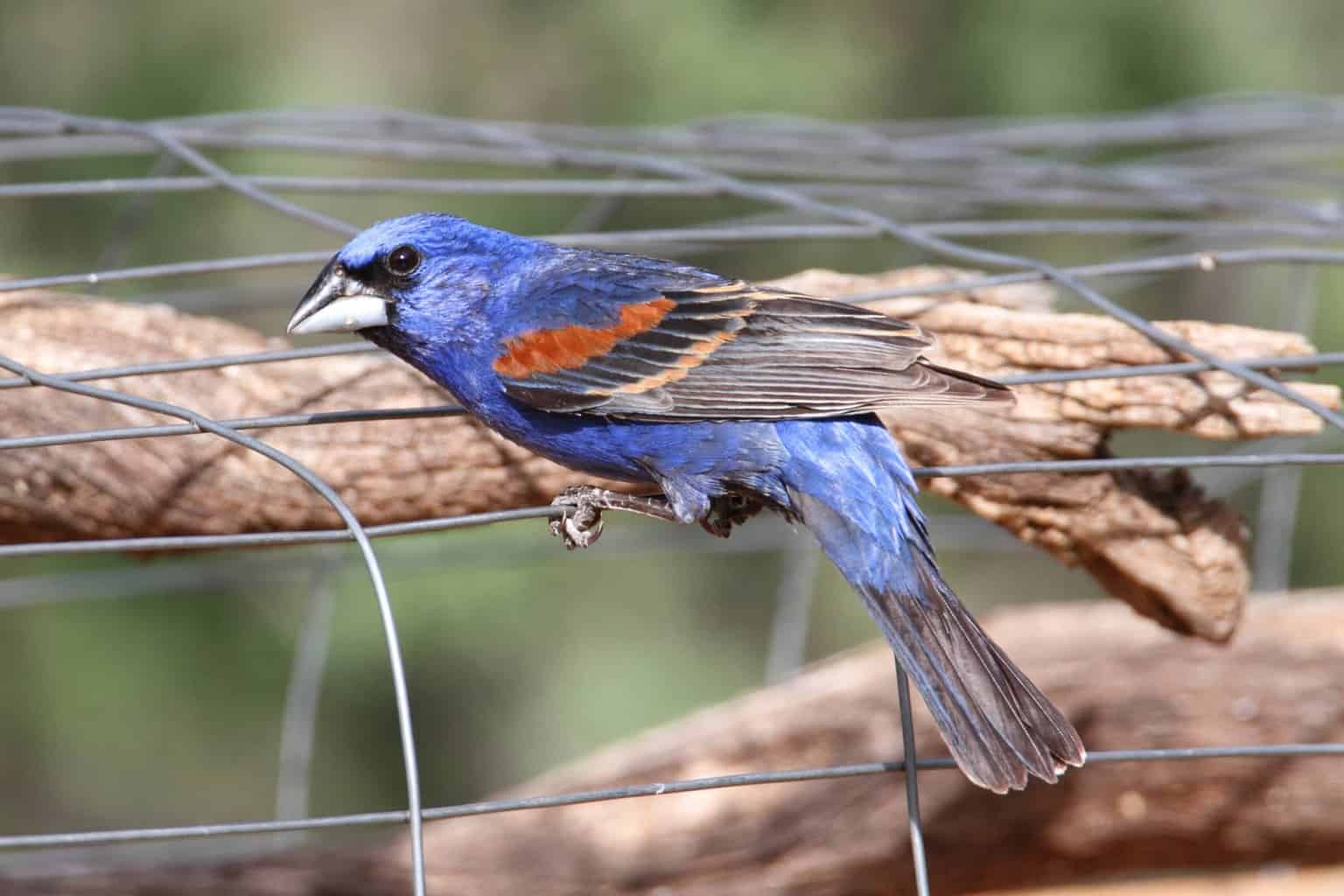
- Scientific name: Passerina caerulea
- Length: 5.9 to 6.3 in
- Weight: 0.9 to 1.1 oz
- Wingspan: 10.8 to 11.1 in
This passerine bird has one of the largest bill to head sizes among all songbirds. However, the bird is typically stocky and petite in size, especially compared to other passerines in the cardinal family.
The bird has a dark blue color that covers its head, belly, and back. The uniquely colored wings of the bird are another characteristic feature, as they have a buff, white, and black-colored streaks.
The bird is commonly found in the southern states, especially around thickets, riparian woodlands, scattered trees, and abandoned overgrown fields.
Green Birds in Mississippi
Ruby-Throated Hummingbird

- Scientific Name: Archilochus colubris
- Length: 2.8 to 3.5 in
- Weight: 0.1 to 0.2 oz
- Wingspan: 3.1 to 4.3 in
The Ruby-throated Hummingbird is easily one of the most common hummingbirds in Mississippi. However, other hummingbirds, such as the Rufous Hummingbird, are also found to a much lesser extent.
Most of the Ruby-throated Hummingbird’s body is covered with iridescent olive green, especially at the back. The belly and sides are typically green too, but they’re much paler.
The most characteristic feature of the adult Ruby-throated Hummingbird, its throat, is covered with shiny ruby red plumage. It also wears a dark black mask that covers its eyes.
Green-Winged Teal
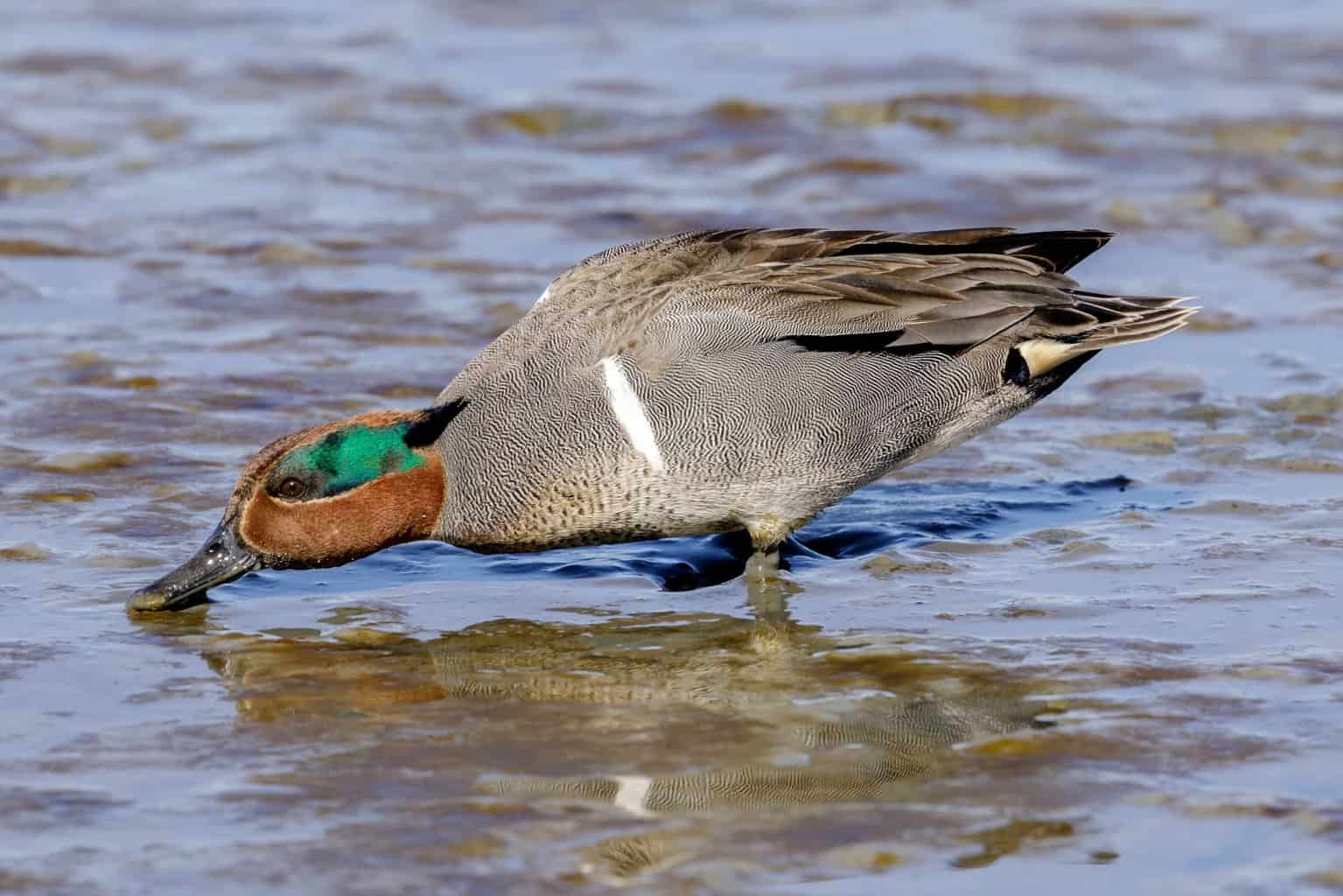
- Scientific name: Anas carolinensis
- Length: 12.2-15.3 in
- Weight: 4.9-17.6 oz
- Wingspan: 20.5-23.2 in
With an expansive range, this migratory bird species spends its winters in the South.
This duck is one of the smallest dabbling ducks you can find in Mississippi, with a body size comparable to that of a pigeon.
The most aesthetically distinct feature of these brown birds is the green patch that extends from the back of their head to their eyes.
White-Eyed Vireo
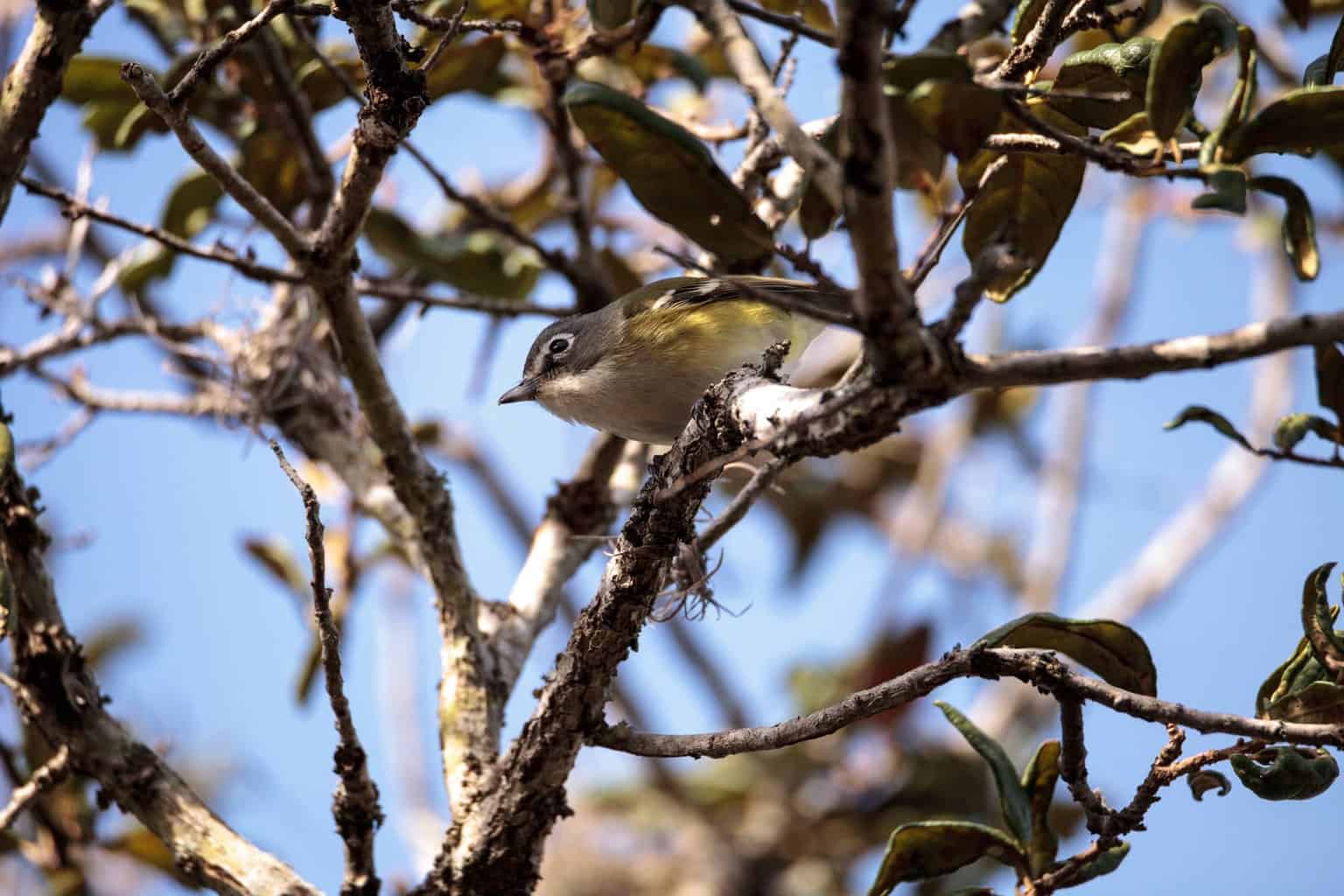
- Scientific name: Vireo griseus
- Length: 4.3 to 5.2 in
- Weight: 0.3 to 0.6 oz
- Wingspan: 6.4 to 6.7 in
Summer in Mississippi marks the arrival of the White-eyed Vireo, which is a relatively small-sized passerine songbird.
The bird has a gray body with a remarkable olive-green plumage on the sides and pale green on the belly. The bird also has a characteristic white ring around its eyes, distinguishing it from other greenish vireos and warblers.
Orange Birds in Mississippi
American Robin

- Scientific Name: Turdus migratorius
- Length: 9.0 to 11.0 In
- Weight: 2.3 to 2.8 oz
- Wingspan: 14.7 to 16.5 In
The American Robin is one of the most common birds in the United States. The birds are well-adapted to the region, and you can typically find them almost everywhere; deciduous woods, gardens, even golf courses. Not only that, but they’re pretty friendly and may approach humans if you offer them seeds.
The Robin is extremely easy to identify because of its unique reddish-orange feather color that covers its breast. They also have a white throat and white patches above the eyes on their black head. Their nests are also fascinating because the birds lay beautiful sky-blue eggs.
Baltimore Oriole

- Scientific Name: Icterus galbula
- Length: 5.8 to 7.8 in
- Weight: 2.3 to 3.5 oz
- Wingspan: 3.5 to 4.7 in
The most common oriole in the Mississippi is the Baltimore Oriole, which is extremely easy to distinguish due to its unique color patterns.
The bird has a vibrant orange coat that extends through its underparts, the wings, and the rump. Females will also have this unique coloration, but they can also have a yellowish paler color.
They are usually found near water in deciduous trees.
The birds are pretty easy to attract, especially if you fill your bird feeder with the types of food they typically enjoy, such as insects, wasps, mealworms, and even commercial nectar mixes!
Yellow Birds in Mississippi
American Goldfinch

- Scientific Name: Spinus tristis
- Length: 4.3 to 5.5 In
- Weight: 0.39 to 0.71 oz
- Wingspan: 7.5 to 8.7 In
Similar to the American Robin, the American Goldfinch is also a native bird species that can be found all across North America, and it’s easily one of the most common in Mississippi.
The bird has a yellow body with black wings and forehead, a beautiful, bright color scheme more vibrant in males than females. The wings also have a distinctive white wing bar.
In addition to the bird’s color, they also fly in a very distinct way, one of the most apparent giveaways of the American Goldfinch. They typically feed on seeds but can also eat small insects.
Hooded Warbler
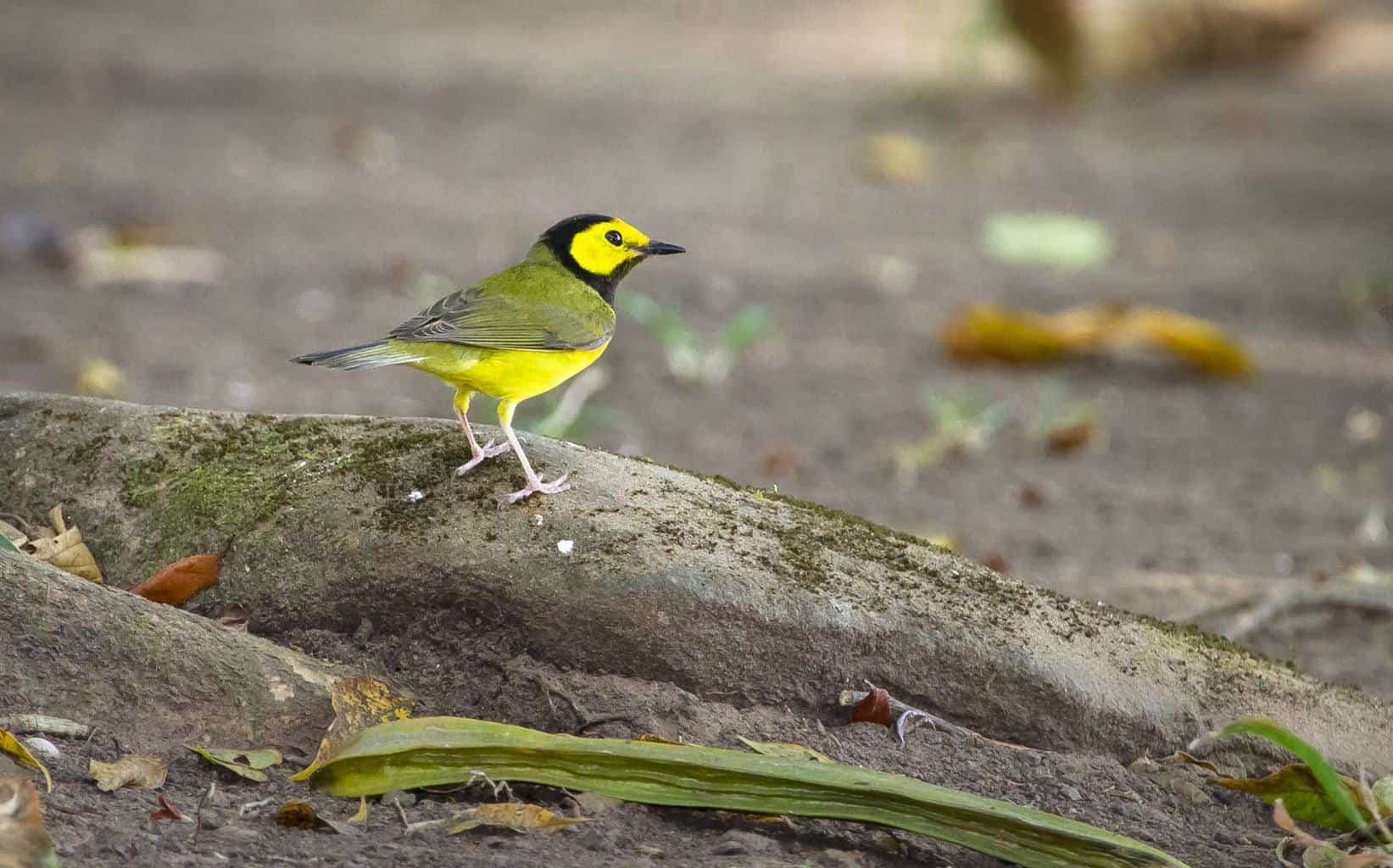
- Scientific name: Setophaga citrina
- Length: 5.1 to 5.3 in
- Weight: 0.3 to 0.4 oz
- Wingspan: 6.5 to 6.9 in
The Hooded Warbler is among the rarest warblers in North America, as they’re only found in a specific range of habitats, including Mississippi.
The bird typically has a bright yellow belly and sides with olive-green upper parts, common in males and females.
However, the males have an extra feature: a black hood covering their heads, hence the name.
Yellow-Rumped Warbler
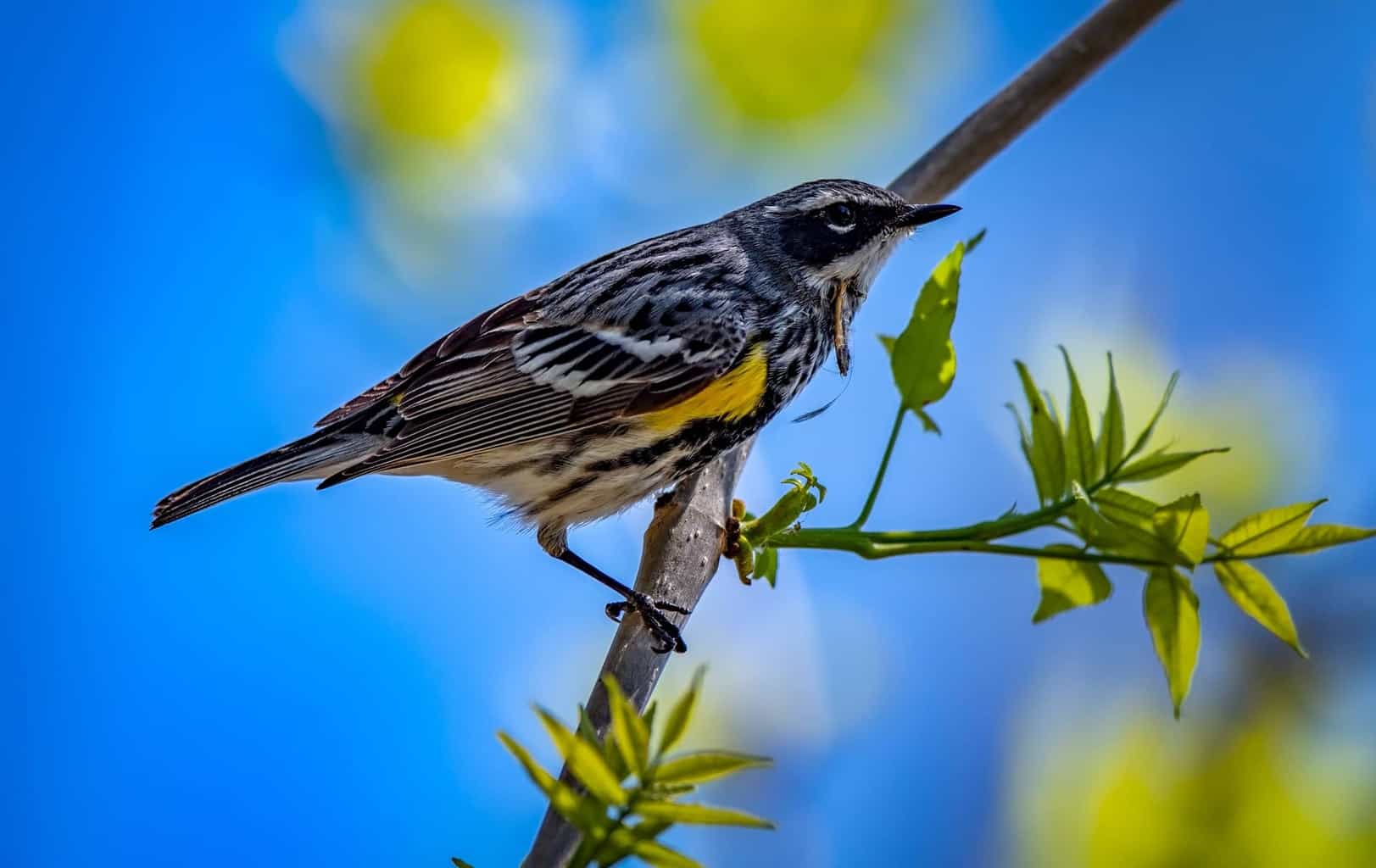
- Scientific Name: Setophaga coronata
- Length: 4.7 to 5.5 in
- Weight: 0.4 to 0.5 oz
- Wingspan: 7.5 to 9.1 in
The most common new world warbler in Mississippi is the Yellow-rumped Warbler. This bird has a unique canary yellow coloration on the rump, sides, and face, making them a delightful bird to watch.
However, the bird is quite challenging to spot because it typically forages on the ground, so it blends easily with its surroundings.
You should keep in mind that this coloration doesn’t last all year, and is only visible throughout the summer months.
You can attract them to your feeder with suet, black oil sunflower seeds, safflower seeds, and peanut butter.
Other Birds in Mississippi
White-Breasted Nuthatch

- Scientific name: Sitta carolinensis
- Length: 5.1 to 5.5 in
- Weight: 0.6 to 1.1 oz
- Wingspan: 7.9 to 10.6 in
The White-breasted Nuthatch is one of the most popular backyard birds in America. The bird is small and stocky with a long bill as well as a short neck and tail. Males have a black crown, while females have a lighter, gray crown.
The white-colored breast separates them from the less common Brown-breasted Nuthatch. Apart from that, both have a blue-gray top.
In addition to residential areas and bird boxes, you can also find the White-breasted Nuthatch in heavy forests in the wild.
European Starling

- Scientific name: Sturnus vulgaris
- Length: 7.9 to 9.1 in
- Weight: 2.1 to 3.4 oz
- Wingspan: 12.2 to 15.8 in
Despite their European origins, these invasive birds are pretty common all over North America, thanks to their excellent ability to adapt to any environment, including heavy-populated areas.
The bird also has a unique iridescent dark, almost black plumage color that will shine with purple and green hues as you observe it from different angles. This special coat is only visible during the breeding season in the summer.
Brown-Headed Cowbirds

- Scientific Name: Molothrus ater
- Length: 7.5 to 8.7 in (males) – 6.3 to 7.9 in (females)
- Weight: 1.5 to 1.8 oz (males) – 1.3 to 1.6 oz (female)
- Wingspan: 14.0 to 14.4 in (males) – 10.0 to 12.6 in (females)
The Brown-headed Cowbird is a medium size bird native to North America. However, their brood parasitic nature makes them bad news for other types of birds.
The birds will typically lay their eggs in other bird species’ nests so that other birds will raise their chicks. They are found in grasslands and along woodland edges.
They have a dark-colored body with a characteristic orange-brown plumage on their head, and females are typically smaller than males.
Mourning Dove

- Scientific Name: Zenaida macroura
- Length: 11.8 to 12.2 In
- Weight: 4.3 to 6.4 oz
- Wingspan: 17.3 to 18.2 In
The Mourning Dove is one of the most common backyard birds in America. They have a characteristic buff color that extends throughout their body. To distinguish them from other doves, you should look for the bright blue rings surrounding their eyes. They also have black spots across the wings.
Like other doves, they typically like to forage at ground level, so you need to spread millet on the ground if you want them to be frequent visitors to your backyard.
Rock Pigeon
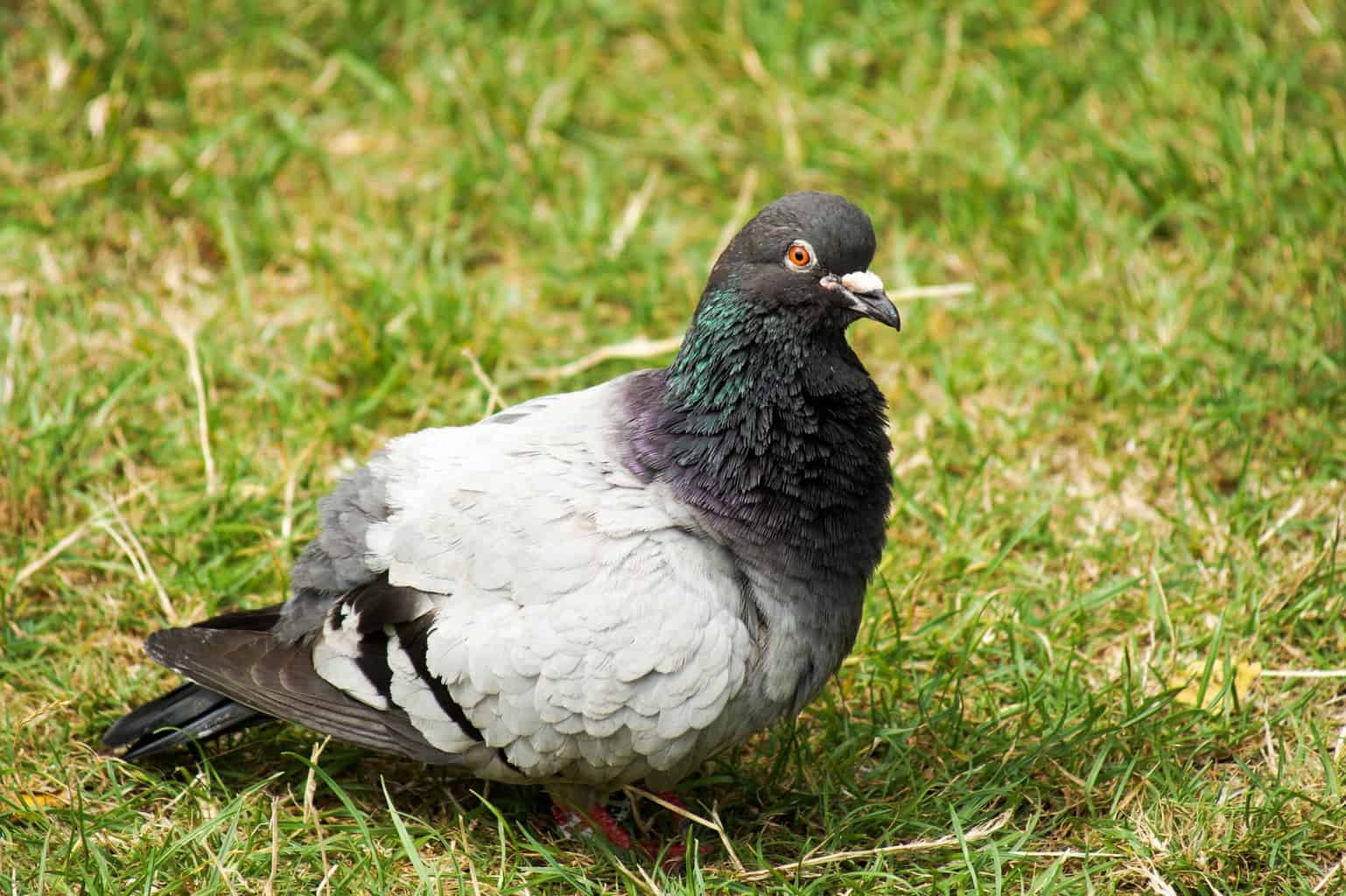
- Scientific name: Columba livia
- Length: 11.8 to 14.2 in
- Weight: 9.3 to 13.4 oz
- Wingspan: 19.7 to 26.4 in
Also known as the “rock dove,” the tubby birds are larger than Mourning Doves and have a much more distinct coloration.
The birds can be found anywhere around the state, as they’re well adapted to anything from rocky cliffs, fields, and farms to cities and large towns.
The Rock Pigeon has a gray feather coat with characteristic iridescent plumage around the throat that shines bright purple and green when facing the sun.
They eat almost anything from birdseed to leftover food.
Great Horned Owl

- Scientific Name: Bubo virginianus
- Length: 18.1 to 24.8 In
- Weight: 32.1 to 88.2 oz
- Wingspan: 39.8 to 57.1 In
If you’re interested in watching night raptors, the Great Horned Owl is your must-see bird. The bird has a unique look and a characteristic hooting call that makes it relatively easy to spot.
The Great Horned Owl has large ear tufts with an orange face and enormous black and white facial rings that cover their faces.
Final Thoughts
You now know more about the fantastic variety of birds in Mississippi. From backyard birds to waterfowls and raptors, the Magnolia State has it all! So get out your bird checklist and go for it!
In addition to backyard birds, the state’s collection of forests is unique and packed with impressive colorful birds, making it a superb spot for bird watchers!

